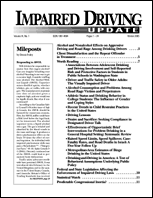Drowsiness and Alcohol: A Dangerous Combination
Author: Anne T. McCartt.
Source: Volume 05, Number 01, Winter 2001 , pp.6-7(2)

< previous article |next article > |return to table of contents
Abstract:
Based on the method of induced exposure and data for drivers with known BAC from the Fatality Analysis Reporting System (FARS), there is an approximately linear relationship between crash risk and BAC. The crash risk doubles for persons with BACS of 0.01% to 0.04% when compared to drivers with zero BAC. (David F. Preusser, Anne T. McCartt, and Susan E. Martin, “Impaired Driving Research Needs and Priorities: General Public,” Trans. Res. Bd. A3B10, Comm. on Alcohol, Other Drugs, and Transportation Summer Workshop (Aug. 1999).) Experimental studies have also documented that alcohol impairs driving-related skills, even at very low BACs. (Herbert Moskowitz and Dary Fiorentino, “A Review of the Literature on the Effects of Low Doses of Alcohol on Driving- Related Skills,” National Highway Traffic Safety Administration (NHTSA), DOT HS 809 028 (Apr. 2000).) While alcohol researchers have not examined the interaction between sleepiness and alcohol, experimental studies conducted by sleep researchers suggest a strong interaction between alcohol and sleepiness such that impairment from alcohol may be significantly heightened when the driver is sleepy. This article summarizes some of the research on the complex relationship between sleepiness and alcohol.Keywords: blood alcohol concentration (BAC); Fatality Analysis Reporting System (FARS); Multiple Sleep Latency Test (MLST);
Affiliations:
1: Preusser Research Group, Inc. (PRG).